On Page SEO for Salesforce Partners – Tips, Best Practices, Strategy and Example
- Updated onJuly 22, 2025
When it comes to ranking higher and driving leads, on-page SEO is essential. In fact, 93% of SEO experts say it’s crucial for success.
As a Salesforce partner, your website isn’t just a digital brochure—it’s a powerful tool to showcase your services and attract qualified Salesforce leads.
With over 150,000 Salesforce customers worldwide, optimizing your pages helps you capture their attention when they search for Salesforce solutions.
Hello, I’m Tarun Bisen. In this blog, we’ll dive into the essentials of on-page SEO for Salesforce partners. My goal is to share actionable strategies from my experience to help you optimize your Salesforce website and drive better search rankings.
Let me show you how.
Must check out this complete guide on SEO for Salesforce
Understanding On-Page SEO for Salesforce Partners
From my experience, on-page SEO is the backbone of ranking higher and driving Salesforce-related traffic. Ignoring it means missing potential leads already searching for your services.
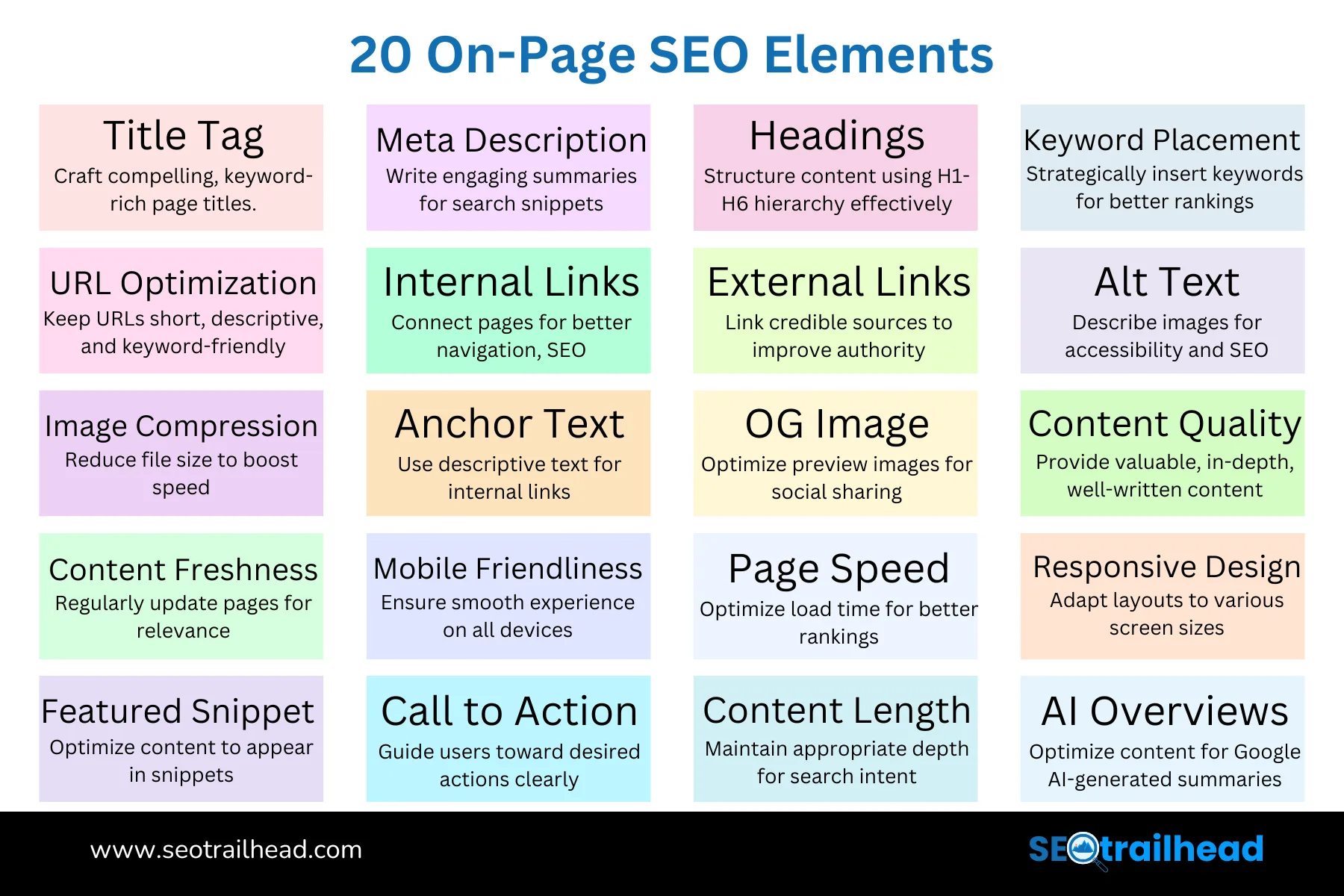

I’ve seen many Salesforce partners lose visibility because they neglect optimizing their pages for key offerings like implementation and customization.
Why on-page SEO matters for Salesforce partners
- Boosts visibility for Salesforce service keywords
- Drives more qualified leads from organic search
- Improves page experience and conversion rates
- Builds authority in Salesforce solutions
Without strong on-page SEO, your competitors will capture the Salesforce clients searching for services you offer. Don’t let them take your share.
With Salesforce generating over $34 billion in revenue annually, I know the competition is fierce. On-page SEO is how you get ahead and stand out.
Key On-Page SEO Elements for Salesforce Websites
When optimizing a Salesforce website, on-page SEO for Salesforce partners isn’t just about keywords—it’s about refining every element that search engines and users evaluate. From my experience, even small optimizations can improve rankings, engagement, and lead generation. Let’s dive into the critical elements you need to focus on.
1. Title Tag
The title tag is the first thing users and search engines see. It defines your page’s topic and influences click-through rates.
I always include primary Salesforce keywords in my titles because keyword-optimized titles can increase CTR.
For example, instead of just “Our Services,” I use “Salesforce Customization Services | [Company Name]” to improve relevance and clicks.
Sometimes Google often directly catches the title from page’s headings. So, it’s equally important to optimize your headings too.
Here’s one of my result:
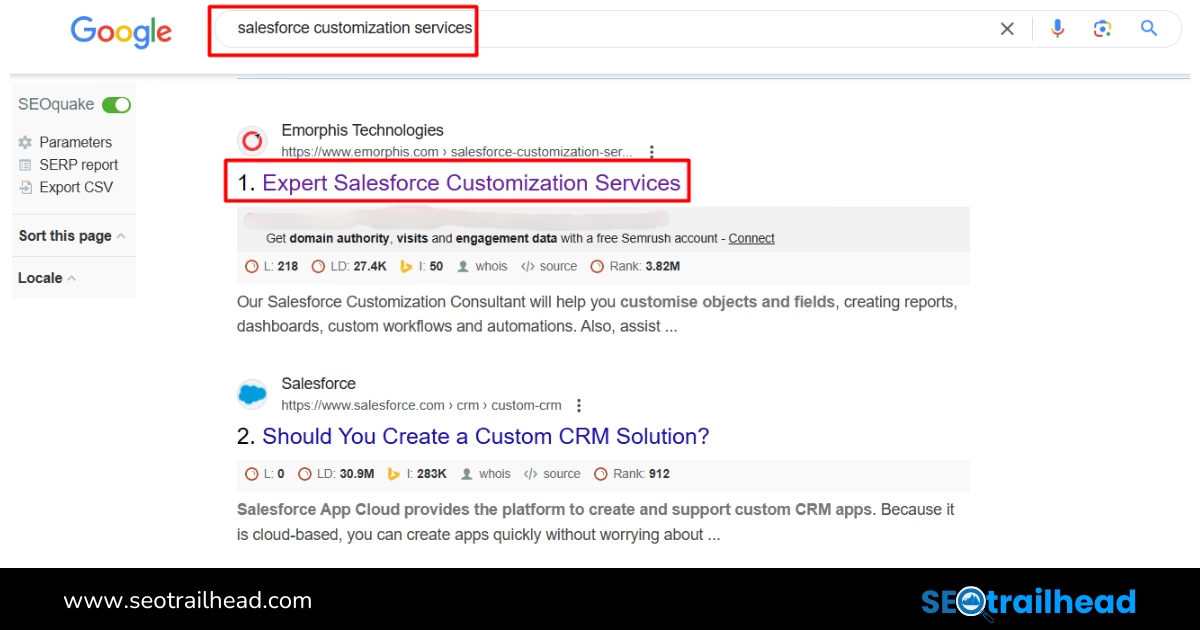

When you click on this result, you will get to know that the “Title Tag” and “The Heading” are the same. That means Google is pulling the relevant title from the page’s content instead of the title tag provided.
2. Meta Description
Meta descriptions provide a brief summary of your page in search results, directly impacting clicks.
I’ve found that including a Salesforce-specific value proposition in my meta descriptions significantly improves organic CTR, especially when paired with a clear CTA.
Suppose you’re optimizing for “Salesforce Integration Consultant” then your meta description should be clear and concise that perfectly defines the query or keyword. Or you can also add some value prepositions with clear CTA like – Get free consultation.
Also, note – Sometimes Google catches the description from the page’s content, so your content must answer the query or have a well defined paragraph for the keyword that you are targeting.
Here’s one of my result:
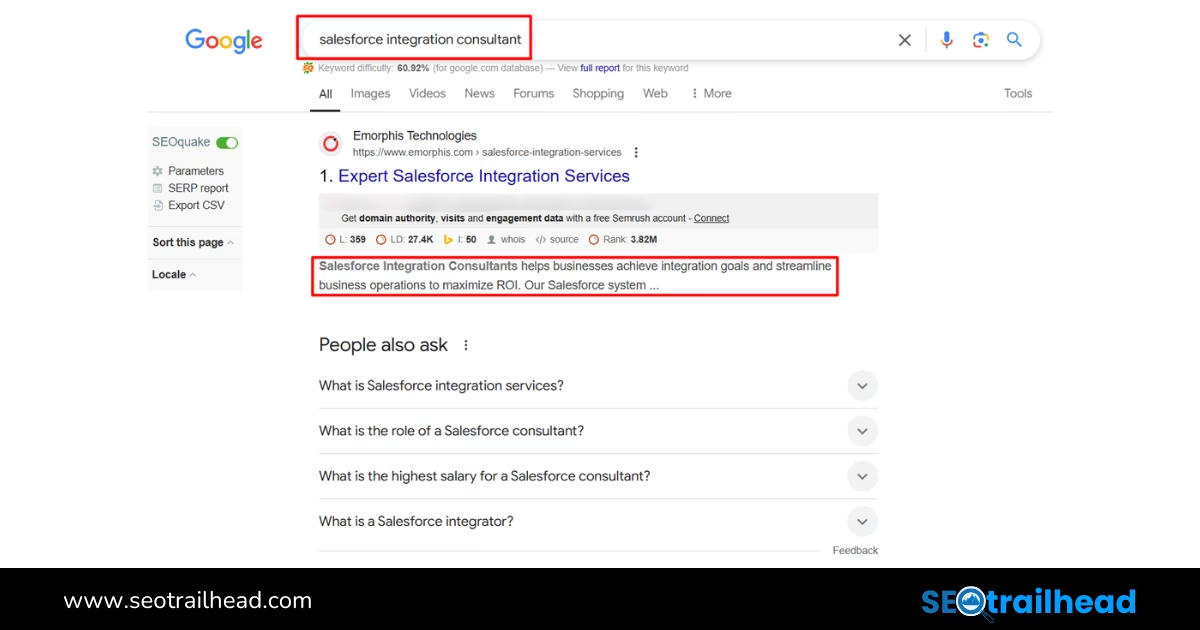

When you click on this result, you will get to know that the “Meta Description” is directly pulled from the page’s content instead of the meta description I provided.
3. Headings (H1, H2, H3)
Headings structure your content, making it easier for both users and search engines to understand.
I use H1 for the main topic, H2 for key subtopics, and H3 for deeper insights. Here’s how I structure a Salesforce partner website:
- H1: Salesforce Services
- H2: Salesforce Implementation Services
- H3: Salesforce Implementation Services for Nonprofits
This structure will help you rank for long-tail Salesforce queries, improving organic visibility.
- H3: Salesforce Implementation Services for Nonprofits
- H2: Salesforce Implementation Services
4. Keyword Placement
Strategic keyword placement signals relevance to search engines.
From my experience, front-loading Salesforce-related keywords in titles, headings, meta descriptions, and the first 100 words accelerates rankings.
Also, for every key term, I write a 250-300 character supporting paragraph to reinforce its meaning. For example: Focused Keyword – Salesforce Customization Consultant
“A Salesforce customization consultant helps businesses tailor Salesforce to their needs, from automation to UI enhancements, ensuring a seamless experience and improved efficiency.”
Since search engines now pull content directly from pages, this approach boosts relevance.
5. URL Optimization
SEO-friendly URLs are short, descriptive, and keyword-rich.
I always structure URLs like /salesforce-implementation-services/ because research shows that keyword-optimized URLs can increase CTR by 45%.
6. Internal Links
Internal links help distribute page authority and improve navigation.
I interlink Salesforce Consulting and Salesforce Implementation pages strategically, reducing bounce rates and enhancing page discoverability. This approach also improves dwell time, which search engines value.
7. External Links
Linking to authoritative sources boosts trust and credibility.
I reference Salesforce’s official documentation and case studies and blogs from other Salesforce communities like Forcetalks and SalesforceBen in my content because pages with high-quality external links get 34% more backlinks, strengthening domain authority.
8. Alt Text for Images
Alt text helps search engines and visually impaired users understand images.
I always write Salesforce-specific alt tags, such as “Salesforce automation workflow dashboard”, which improves image search rankings and accessibility.
9. Image Compression
Page speed is crucial, and uncompressed images slow down websites.
I use TinyPNG or WebP formats to reduce image sizes without quality loss, ensuring pages load faster. Google data shows that 53% of users leave if a page takes over 3 seconds to load.
10. Anchor Text
Anchor text should be descriptive and keyword-rich.
I avoid generic text like “click here” or “learn more” and instead use precise phrases like “Get Free Salesforce Implementation Consultation”, as Google recommends avoiding vague anchor texts.
11. OG Image (Open Graph)
OG images appear when sharing pages on LinkedIn, Twitter, and Facebook.
I design custom Salesforce-branded OG images, increasing engagement and click-through rates, especially on LinkedIn.
12. Content Quality
High-quality content is key to user engagement and rankings.
I focus on solving Salesforce partners’ specific pain points, ensuring my pages are three times more likely to earn backlinks.
13. Content Freshness
Fresh content ranks higher and attracts more clicks.
I update my partners’ Salesforce blogs every quarter, ensuring they stay relevant, as outdated content can drop in rankings significantly.
14. Mobile Friendliness
Google prioritizes mobile-first indexing, so mobile optimization is essential.
I ensure partners’ site passes Google’s Mobile-Friendly Test because 61% of users abandon sites that aren’t mobile-optimized.
15. Page Speed
A fast-loading website improves user experience and rankings.
I optimize page speed using Google PageSpeed Insights, ensuring load times are under 3 seconds.
However, I’ve observed that strong content can sometimes outweigh minor speed issues—but speed should never be ignored.
16. Responsive Design
A responsive website adapts to different devices, improving usability and SEO.
I always ensure Salesforce partner sites are mobile-responsive, as Google prioritizes mobile-friendly sites in rankings.
17. Featured Snippet Optimization
Featured snippets drive higher visibility and CTR.
I’ve won snippets by using clear headings, bullet points, and direct answers, resulting in a traffic increase for Salesforce-related searches.
Here’s one of my result:
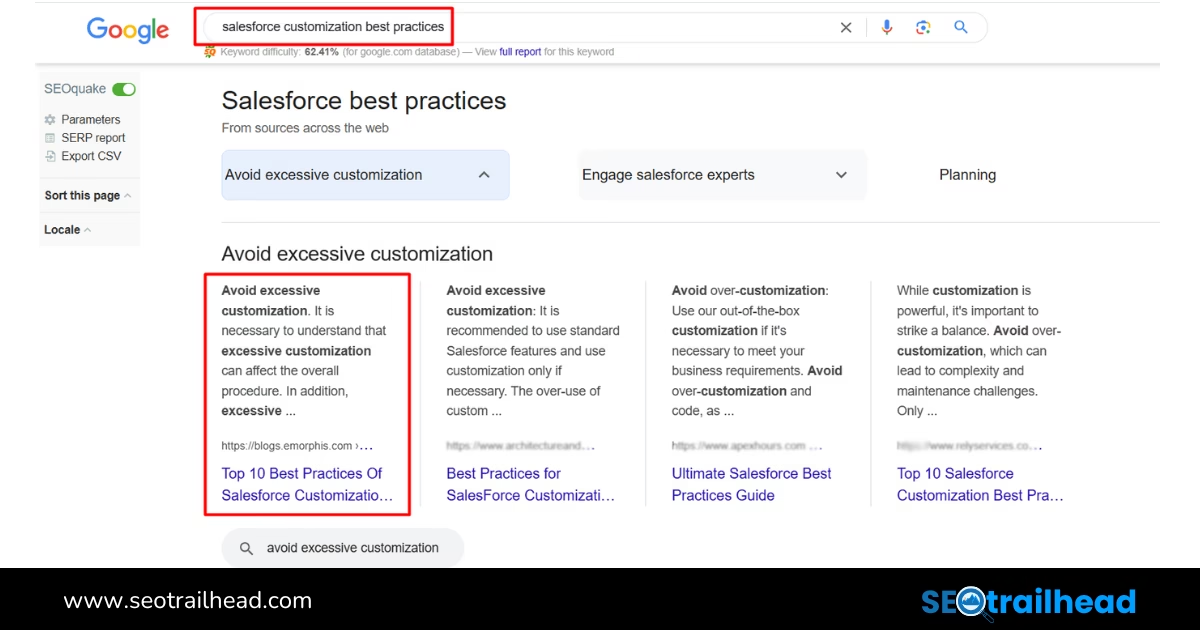

18. Call to Action (CTA)
CTAs guide users toward conversions.
For Salesforce partners, I recommend clear CTAs like “Get a Free Salesforce Consultation”, which has significantly boosted engagement and leads.
19. Content Length
Long-form content ranks better. Backlinko found that top-ranking pages average 1,447 words.
I ensure my Salesforce-focused blogs exceed this benchmark, combining depth with actionable insights to maximize rankings and engagement.
20. Optimize for Google AI Overviews
With Google’s AI Overviews reshaping search results, optimizing for them is crucial. I focus on providing clear, well-structured answers to common Salesforce SEO queries. Using concise paragraphs, bullet points, and schema markup has helped my content appear in AI-generated summaries, driving more organic traffic.
Here’s one of my result:
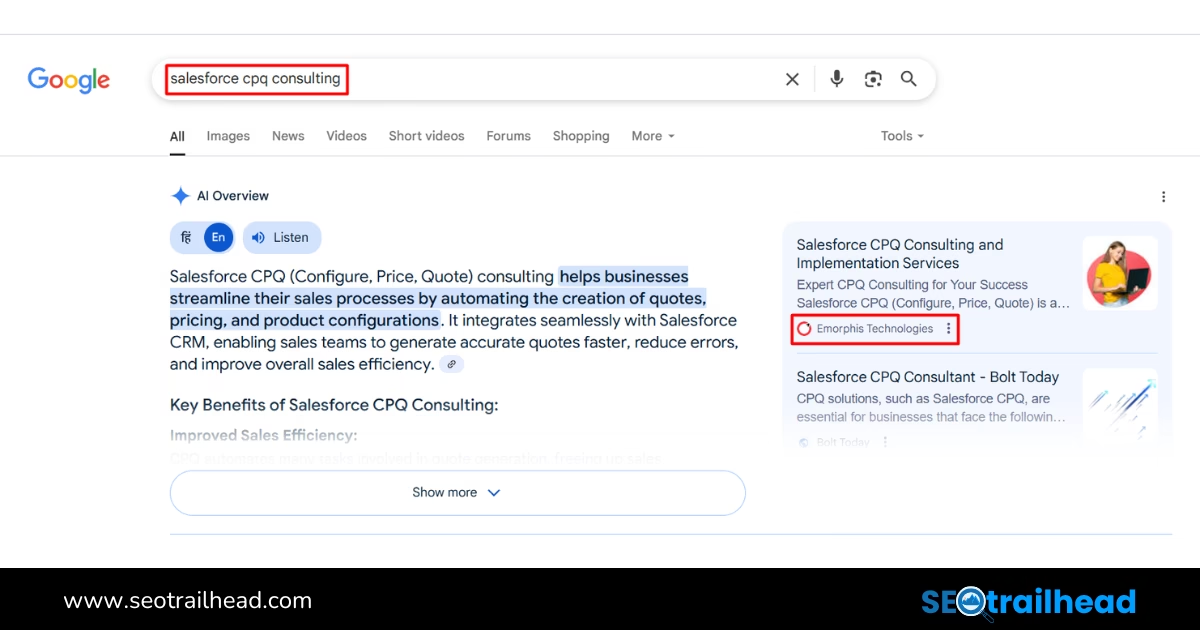

How to Craft a Winning On-Page SEO Strategy
From my experience working on Salesforce websites, here’s how I execute on-page SEO for Salesforce Partners to drive results:
Step 1. Do Keyword Research (Primary, Secondary, Tertiary)
I break down keywords into three categories for better targeting:
- Primary: The main keyword (e.g., Salesforce implementation services)
- Secondary: Related keywords and modifiers
- Tertiary: Synonyms and LSI keywords
I use tools like Google Keyword Planner and SEMrush, focusing on high-intent keywords that Salesforce prospects search for.
Step 2. Craft Well-Optimized Content That Answers User Queries
I write in-depth content that directly addresses Salesforce partners’ pain points, ensuring visitors find solutions immediately. My goal is always to solve real user queries to reduce bounce rates and increase engagement.
Step 3. Include Keywords in Key SEO Elements
I ensure Salesforce-focused keywords are placed strategically:
- SEO Title and Meta Description: For better CTR
- Alt Text: To drive traffic from image search
- Headings (H1, H2, H3): For content structure and relevance
- Within the First 150 Words: To signal relevance to search engines
Step 4. Use Clear CTAs and Descriptive Anchor Text
I always include Salesforce-relevant CTAs like “Get a Free Salesforce Consultation” and use descriptive anchor text, such as “Learn more about Salesforce implementation” instead of generic phrases like “click here.”
Step 5. Build Strong Internal and External Links
I connect related Salesforce pages internally and add outbound links to credible sites like Salesforce blogs or case studies. This not only boosts SEO but also provides additional value to my readers.
Step 6. Prioritize Mobile Friendliness and Page Speed
I test all pages using Google’s Mobile-Friendly Test and optimize loading times with tools like Google PageSpeed Insights. Fast-loading, mobile-optimized pages are non-negotiable for me.
Step 7. Maintain Content Quality and Freshness
I update Salesforce blogs quarterly to keep them current and competitive. Fresh content has helped me outrank outdated pages and stay ahead in search results.
Step 8. Optimize for Featured Snippets
I structure content using clear headings, FAQs, and bullet points. This approach has helped me win featured snippets for Salesforce-related queries and drive more organic traffic.
Step 9. Add Structured Data (Schema Markup)
I implement schema markup (like FAQ and How-To) to help search engines understand my content, which boosts rich results visibility.
Step 10. Analyze and Improve Continuously
I monitor performance using Google Analytics and Search Console, identifying which pages drive traffic and which need improvement. Data-driven optimization is key to my strategy.
Also, don’t forgot to explore Off-Page SEO for Salesforce
Best Practices and Tips
From my experience, mastering on-page SEO for Salesforce partners requires a strategic approach that balances search engine optimization with user experience. Here are my top best practices:
- Focus on search intent by aligning content with Salesforce service-related queries.
- Use primary keywords naturally in titles, headings, and within the first 150 words.
- Write unique meta descriptions with a Salesforce-specific value proposition.
- Use short, keyword-rich URLs that clearly describe the page content.
- Optimize images with descriptive alt text containing Salesforce-related terms.
- Add internal links to related Salesforce service pages for better site structure.
- Include external links to authoritative Salesforce resources for added credibility.
- Ensure mobile-friendly, fast-loading pages by compressing images and using responsive designs.
- Use clear, action-driven CTAs like “Get a Free Salesforce Consultation” to drive conversions.
- Update content regularly to maintain freshness and rank for new Salesforce search queries.
Trailhead Takeaways
We’ve covered a lot in this guide, haven’t we? From optimizing title tags to perfecting content structure and implementing strategic internal links, I hope you now have a clear roadmap to enhance your on-page SEO for Salesforce partners.
Here are the key lessons from this guide to get your SEO strategy rolling:
- Start with Strong Keyword Research
- Craft Content with User Intent in Mind
- Optimize Every SEO Element
- Leverage Internal and External Links
- Focus on Mobile-Friendliness and Page Speed
- Keep Content Fresh and Valuable
- Use Clear CTAs
- Aim for Featured Snippets
- Ensure Responsive Design
- Track Performance and Refine
As someone who’s walked this trail for years, I can confidently say that a well-optimized on-page SEO strategy is a game-changer for Salesforce partners.
Now it’s your turn—implement these strategies, track your results, and watch your Salesforce website climb the search rankings.
Tarun Bisen is an SEO strategist specializing in Salesforce and digital marketing. He helps businesses improve search rankings and generate leads. Passionate about SEO, technology, and industry trends, he shares insights on ranking strategies and organic growth.
Most Recent Posts
The best trails are the ones we blaze together. Thanks for exploring with me at SEO Trailhead—cheers to your growth!



